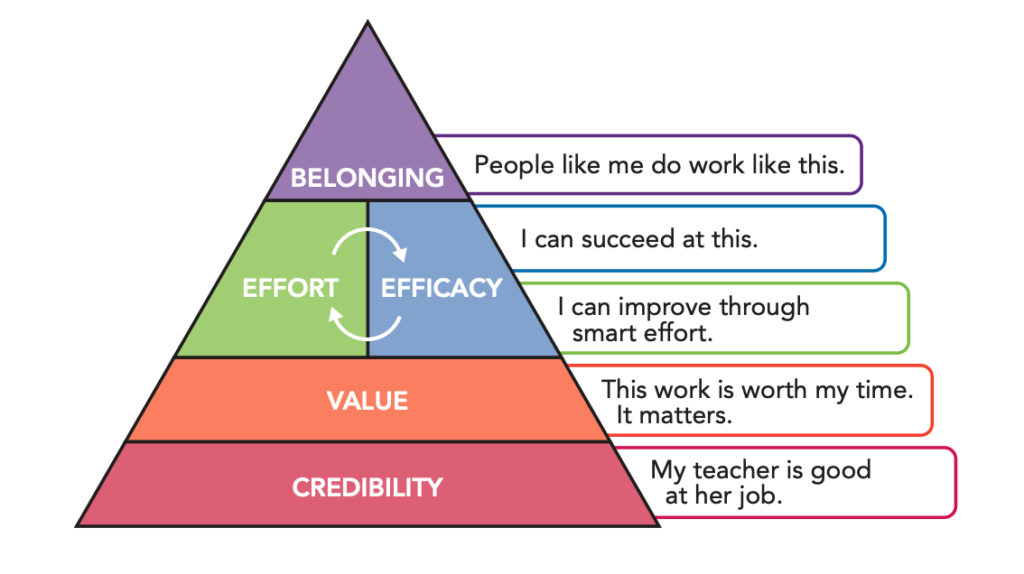Dear colleague,
Picture Sarah, a sophomore in your third-period class. She's not disruptive, but she's not engaged either. When you ask her why she should care about what you're teaching, she shrugs and says, “I don't know. For the grade, I guess?”
Sarah's not lazy or defiant. And if you asked what Stanford researcher Bill Damon thought was going on here, he'd likely argued Sarah is just part of the 80% of young people who lack what he calls “true purpose.”
Purpose gets plenty of play in school parlance, so let's put Damon's clear definition on it to make sure we're on the same page. Purpose is a clear sense of what I'm here for and how my life can make a positive impact on the world. Or to quote directly from Damon:
Purpose is a stable and generalized intention to accomplish something that is at the same time meaningful to the self and consequential to the world beyond the self.”
Here's why Damon's research is apropos to any of us who work with the Five Key Beliefs methodology I unpack in The Will to Learn.
The Purpose Gap
Damon's research (popularized in his book The Path to Purpose) reveals that only about 20% of adolescents have developed a stable sense of purpose. The rest? Unmoored by a sense of purpose, they drift, often experiencing higher rates of anxiety, depression, and disengagement.
But when young people do have purpose, Damon finds that a whole lot changes: higher academic achievement, greater resilience, increased engagement, and deeper well-being.
This is where things get exciting for those of us cultivating the Five Key Beliefs.
Purpose as a Deeply Powerful Source of Value
In The Will to Learn, I describe meaning and purpose as “nuclear fusion reactors of the Value belief.” Damon's research is part of why I know that to be true.
When students can connect their learning to a larger purpose, they stop asking, “When will I ever use this?” Instead, they think:
- “I'm going to become a nurse, so anatomy class matters to me.”
- “I want to serve my country, so I'm all in on physical education.”
- “My mom had cancer, so health class feels personally significant.”
- “If I'm smart, I can do more good in the world. So I'm here to learn.”
Damon identifies three components of true purpose that align beautifully with our Five Key Beliefs:
- Personal Meaning maps onto Value: Students believe the work matters to them personally.
- Goals and Intentions map onto Effort and Efficacy: Students see a clear path forward and know what kind of effort pays off.
- Beyond-the-Self Impact maps onto Belonging: Students feel connected to something larger than themselves.

When students experience purpose, they're also more likely to see us as Credible guides worth following.
So, How Does Damon Advise We Develop Purpose in Young People?
There are a few things we can do that will reliably help here.
- For starters, Damon urges teachers to tell students why we're teachers. One of the best predictors of the development of purpose in young people is the presence of what he calls purpose exemplars in their lives. A lot of times, us teachers forget to periodically tell our students WHY we do what we do. When we push into those narratives, it helps them see what it can look like to be a person driven by a sense of purpose. (I write about this more here.)
- We can also lean harder into our mini-sermons (Strategy #4 of The Will to Learn). These brief, 30- to 90-second speeches help students connect the day-to-day humdrum of learning with the bottommost parts of the Rainbow of Why. Mini-sermons aren't optional in today's classrooms; they are essential to Value cultivation in general, and they help a lot with purpose development when we speak into the purpose of learning math or science or whatever we're teaching.
- Connect to justice and prosocial themes. I love the Bryan et al study that found students ate healthier when they learned about manipulative food industry practices. (See this blog article or pp. 111-112 of The Will to Learn.) That's the power of purpose in action right there.
- Help students see the bigger picture. Purpose development doesn't require abandoning your curriculum; in fact, that would be the opposite of what you want to do because your curriculum is going to HELP students realize their purpose, no matter what you teach. Instead of doing that, as we're teaching what we teach, we can periodically guide students to connect it to the questions of purpose: Who am I? What am I here for? How can I contribute? (See Strategy #6 in The Will to Learn or this article for a deep dive on how this is done.)
The gist
Damon's research doesn't just align with the Five Key Beliefs—it validates the urgent importance of our work. When we cultivate the will to learn, we're not just improving test scores. We're helping young people discover what they're here for.
In a world where four out of five students are like Sarah—drifting without clear purpose—that work has never been more essential.
Teaching right beside you,
DSJR
P.S. What's your experience with helping students connect to purpose? I'd love to hear in the comments!
Leave a Reply